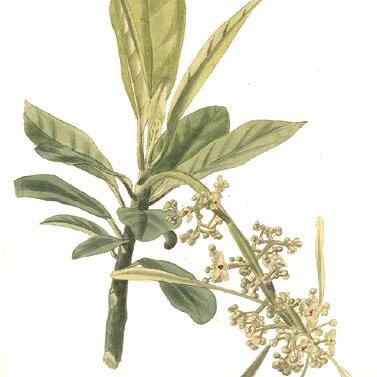Shrubs, lianas, or small trees, with clear latex; monoecious. Leaves alternate (sometimes approximate at ends of branches), distinctly petiolate, stipulate; blades large, pinnately veined but often 3-nerved at base, entire to deeply lobed, usually with 2 large glands at junction with petiole. Inflorescence paniculate (a compound thyrse); floral bracts often conspicuous and foliose; cymules d or I. Staminate flowers short-pedicellate; calyx-lobes 4, decussate (rarely 5 and imbricate); petals absent; disc patelliform, fleshy, entire; stamens 2 or 3, the filaments connate, the connectives of anthers connate into a large fleshy disciform mass with anthers at the periphery, the anthers dehiscing obliquely; pollen grain oblate, 3-colpate, tectate (psilate); pistillode absent. Pistillate flowers short-pedicellate; calyx-lobes 4 (rarely 5); petals absent; disc annular, sometimes indistinct; ovary of 3 carpels, with 1 ovule in each locule, the styles connate into a stout column which is entire or barely 3-lobed at the apex. Fruits fleshy but ultimately dehiscing into 3 1-seeded woody cocci; seeds subglobose, ecarunculate, endosperm present, the cotyledons broad, cordate at base.
Shrubs, trees or lianes, evergreen, perennial, monoecious; stems with watery latex. Indumentum of simple trichomes, not glandular, stinging hairs absent. Stipules entire, caducous. Leaves alternate, petiolate, elobate to lobate, entire, palminerved or penninerved, glands usually 2 at petiole apex. Inflorescences terminal or subterminal, paniculate or racemose, solitary, bisexual, with flowers in bracteate clusters. Male flowers pedicellate; calyx lobes 4 or 5, free, imbricate; petals absent; disc absent or of fleshy lobes; stamens 2 or 3, filaments connate into a short column; anther connectives connate into peltate pileiform mass, bilobate, thecae oblong and longitudinally dehiscent; pistillodes absent. Female flowers pedicellate; calyx lobes 4 or 5, free, imbricate; petals absent; disc absent or poorly developed; ovary 2-or 3-locular, ovules uniloculate; styles connate into a short column, obtuse or shortly lobed. Fruits drupaceous, indehiscent, bi-or triloculate; sarcocarp fleshy, surface smooth; endocarp woody. Seeds subglobose, ecarunculate; testa crustaceous; albumen fleshy; cotyledons broad, flat.

